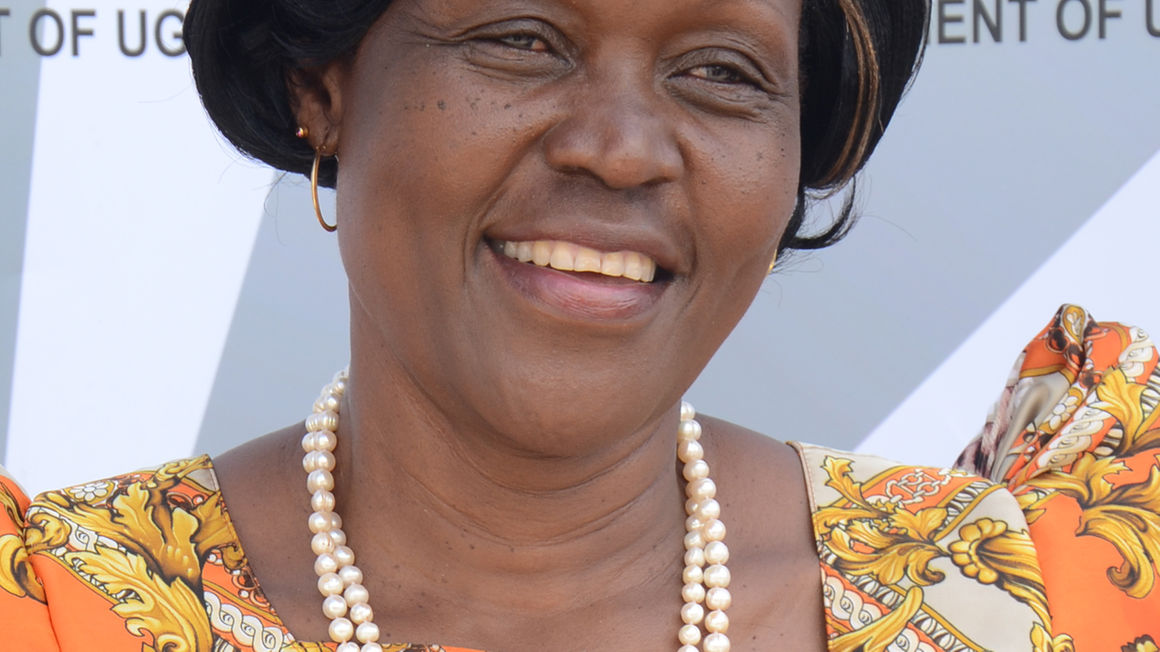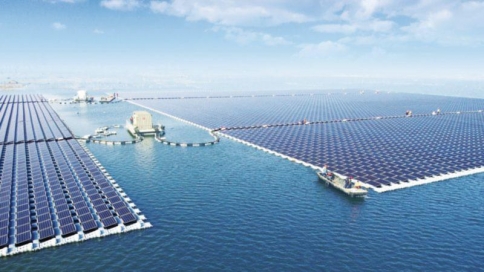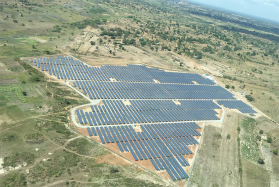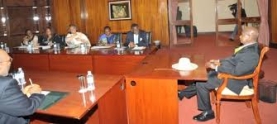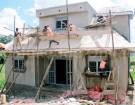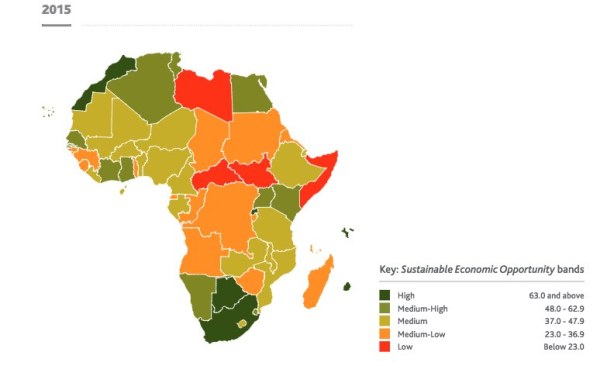Introduction
Water and Environment is a key sector of the economy because it provides a cushion to all other sectors by way of providing nearly all inputs in the production processes and human living. Human livelihood entirely depends on the water and environment sector.
The availability of adequate water resources is a critical catalyst in hydro-power development, agricultural production and productivity, livestock, fisheries, health, industrial development, tourism development and mitigation of climate and climate change effects.
A healthy, clean and productive environment is essential in boosting wealth creation for social transformation and sustainable development because it reflects the balance between the demand and supply of natural resources on one hand and the absorption and supply of waste products on the other hand in the development process.
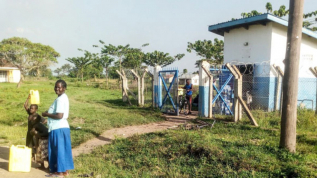 Residents of Nabukalu Sub-county on January 28 fetching water from the Shs2b solar-piped water plant, which was constructed by National Water and Sewerage Corporation.
Residents of Nabukalu Sub-county on January 28 fetching water from the Shs2b solar-piped water plant, which was constructed by National Water and Sewerage Corporation.
Sector achievements
Rural and small towns water supply
Our target was to increase access to clean and safe water from the 65 per cent to 79 per cent in rural areas and from 77 per cent to 100 per cent in urban areas by 2021. Currently, the rural water coverage is estimated at 69 per cent, while the urban water coverage stands at 79.1 per cent.
A total of 38,517 villages representing 66 per cent out of the total 57,974 villages in the country have been served with clean water. So far, 35 districts have their water coverage above 80 per cent. The sector has managed to construct 132,341 domestic water points countrywide of which 41,112 (deep boreholes), 21,590 (shallow wells), 29,097 (protected spring), 20,306 (PSP/taps) and 20,236 (rain water harvesting tanks) serving 27, 797,316 people.
The manifesto pledged an annual target of drilling 5,000 boreholes in five years at a rate of 1,000 boreholes per year and fitted with hand pumps based on their yield. To date, the sector managed to drill 846 boreholes per year translating into 84.6 per cent performance. These boreholes have helped serve an extra 253,800 people.
Gravity flow schemes designs have been completed and construction underway in some towns as follows:
- Water Schemes completed: Nyarwodho GFS-Phase II in Nebbi District, Bududa-Nabweya GFS Phase II in Bududa District, Bukwo GFS Phase II in Bukwo District Phase II,Rwebisengo Kanara GFS in Ntoroko District.
- Ongoing construction: Lirima – Phase II (Manafwa) at 93.8%: Bukedea (Sironko, Kween, Kapchorwa, Bulambuli) at 98%, and Orom (Kitgum) at 44%,
- Completed design and feasibility: Bwambara- Bugangari (Rukungiri); Nyamugasani (Kasese); Ngoma–Wakyato (Nakaseke); Ogili (Agago); Potika (Lamwo).
It was further pledged to rehabilitate and expand four gravity flow schemes. Construction of three out of four water supply schemes is progressing at Nybuhikye and Kikyenkye (Ibanda) at 64%, Shuuku and Masyoro (Sheema) at 93% and Lukalu-Kabasanda (Butambala) at 59%. Construction of Bitysa water supply scheme in Buhweju District commenced recently.
The target to construct 19 water supply systems in selected towns was completed and surpassed. So far 36 schemes were constructed and are benefiting 547,670 people in 40 towns.
On a pledge to construct 10 new town piped water systems, seven new towns in Kasagama, Kinuuka, Namagera, Nyahuka, Iziru, Busede-Bugobya and Kaperabyong, Kayunga including Kamuli FSM were completed. Four new towns of Mpara Nakasongola, Nakapiripirit and Kyamuhunga are under design phase.
The pledge to design and construct 33 piped water supply systems is at various levels implementation. For example, construction of six water supply schemes was completed in Bulegeni, Kacheri-Lokona, Bugobya, Bulambuli, Namayingo, and Olilim. Those on going include five towns of Kagadi (70%), Nazigo (20%), Kasanda (18%), and Ofua (60%), 13 towns have been designed to completion, six towns are still under design, and three towns not yet designed in Mukura, Baale and Wobulenzi.
Sanitation
The national average sanitation coverage in rural areas has increased from 77 per cent to 79 per cent. While sanitation in urban areas has increased to 87.4 per cent with five faecal sludge management plants are constructed in Pallisa, Apac Kiboga Nakasongola, and Kamuli while 101 public water borne toilets have been constructed and four cesspool emptiers procured.
The NWSC increased sewerage connections to 23,796. The total sewer network is 670kms countrywide representing 30 per cent.
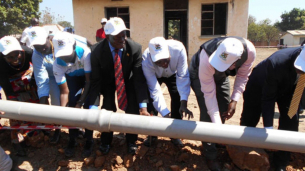 Moyo local leaders and officials from Water and Environment ministry carry a pipe during a ground-breaking ceremony of Moyo Town Council Water Supply and Sanitation project on 14 January,2021.
Moyo local leaders and officials from Water and Environment ministry carry a pipe during a ground-breaking ceremony of Moyo Town Council Water Supply and Sanitation project on 14 January,2021.
Large towns water supply
NWSC installed a total of 12,028 Public Stand Pipes (PSPs) serving 9,909 villages and benefiting an estimated 10.6 million people. The expansion of pipe water main network system aiming at serving all Ugandans with water has since increased from 9,960 km to 19,268Km while the total number of new connections effected in various areas during the manifesto period stands at 222,091. The total customer base covering industrial/institutions/commercial customer increased from 472,193 to 711,556 connections to date.
With respect to Presidential Guidelines and Directives, NWSC has extended water in the constructed industrial parks to improve water supply and avail sufficient water for future developments as follows:
Bweyogerere Industrial and Business Park is under the management of NWSC Seeta Branch, Luzira Industrial and Business Park receives water supply from the NWSC Mutungo tank, Kasese Industrial and Business Park, the NWSC provided a pipe along the lower boundary of the park and the existing project has been connected and provided with water supply while Soroti Industrial and Business Park has been initially connected,
Those not yet connected are Kashari Agricultural Land in Mbarara, Mbale Industrial and Business Park Sewerage Services for the Industrial Parks. Preliminary construction process still underway at Kapeeka Industrial and Business Park: NWSC in the process of designing a water supply system expansion project for Karamoja Industrial and Business Park.
The rehabilitation and expansion of water systems in selected large towns under NWSC is as follows:
- Bushenyi Project was substantially completed and the water supply systems is under operation providing an additional 3,150,000 litres of water per day.
- Arua Project was substantially completed and the water supply system is in operation. Plant capacity was upgraded from 3,500,000 litres per day to 12,000,000 per day, and an extra ground water system of 4,500,000 litres per day was developed serving over 309,000 people.
- Gulu Project. Works for Karuma intake completed. Rehabilitation of the water treatment plant was substantially completed. It involved upgrading and expansion of the existing water treatment plant from 4,000,000 litres per day to 10,000,000 litres of water per day.
- Mbale Project. Involves construction and rehabilitation of water supply and sanitation infrastructure in Mbale Municipality. Procurement is ongoing.
- Kapeeka Water Supply: Upgraded Kapeeka industrial Water Supply to 2,500,000 litres per day. Phases 2 that entails extra 5,000,000 litres per day is ongoing.
- Kampala Sanitation Project: Completed Bugolobi Waste Water Treatment Plant of capacity 45,000,000 litres per day; rehabilitation and expansion of Nakivubo and Kinawataka sewers (29 km) project; Kinawataka pre-treatment plant and pumping stations of capacity 9,000,000 litres per day.
- Lake Victoria Water and Sanitation Project: Upgraded and rehabilitated Ggaba water treatment complex including a water storage reservoir of 8 million litres at Namasuba and laying of 9.6 km Ggaba-Namasuba pipe line, Construction of a water treatment plant at Katosi East of Kampala of 160,000,000 litres per day is ongoing at 60% complete and transmission main from Katosi of 56 kms at 85% complete.
- Kapchorwa Water Supply Project: Completed new water works with capacity of 3,000,000 litres per day and 4,000-metre delivery main.
- Fort Portal Water production Improvement project: Increased water production by 2,500,000 litres per day.
- Sembabule Water Supply Project: The project works aim at increasing water production from 300,000 litres per day to 3,000,000 litres per day. Project works have commenced.
- Package sewer treatment plants at Fort portal and Kisoro: The project involved design, supply, installation and operation of sewage treatment plants for both towns, and was completed.
- Masindi/Hoima Albertine Graben Cluster Feasibility and Pre-design was completed. However, funds for the project are not yet secured.
- Mbarara Masaka South Western Cluster: The project aims at upgrading, expanding and developing water and sanitation infrastructure in Masaka, Mbarara and Isingiro, and the neighbouring towns. Procurement of works contract for Isingiro and Mbarara is ongoing, while Masaka project component is undergoing detailed design. The project is expected to serve over 1,000,000 people.
Water for production
The emphasis is on construction of large and small scale water schemes for irrigation, livestock and rural industries.
Overall the manifesto target is to realize a cumulative storage capacity of 55 Million Cubic Metres (MCM) by 2021. The current cumulative storage for water for production stands at 41.124 Million Cubic Meters (MCM) translating into 71.5% of the above projected manifesto target. The irrigation area stands at 19,138ha against the irrigation potential estimated at 3.03m Ha. In line with the above, the sector has managed to achieve the following:
i. Completed construction of 70 Small scale Irrigation systems in districts of Pallisa, Bukedea, Katakwi, Tororo, Kamuli, Bugiri, Soroti, Abim, Kaabong and Mayuge Soroti, Abim, Napak, Kaabong, Iganga, Pallisa, Mayuge, Kamuli, Bukedea, Tororo, Katakwi, Amuria, Ngora, Manafwa, Kibuku, Bugiri, Nwoya, Zombo, Lira, Pakwach, Gulu, Omoro, Alebtong, Oyam, Arua, Nwoya, Adjumani, Dokolo, Rukiga, Isingiro, Lyantonde, Mukono, Kiboga, Masaka, Kabarole, Butambala, Gomba, Masaka, Mbarara, Bushenyi, Mbarara, Kyankwanzi, Mityana, Ntungamo, Kalungu, Kagadi, Kisoro, Wakiso, Kamwenge, Kabarole, Kyegegwa and Kasanda.
ii. The sector completed reconstruction of Mabira dam in Mbarara District with total storage capacity of 1,443,959 cubic meters.
iii. The sector is constructing six medium scale irrigation schemes with a total of 3,976 hectares. These include, Rwengaaju in Kabarole District standing at 70%, Tochi (500ha) in Oyam District standing at 86% completion level, Mubuku-II (480ha) in Kasese District stands at 63%, Doho-II (1,178ha) in Butaleja District is at 80.5%, Ngenge (880ha) in Kween District is 87.5% and Wadelai (1,000ha) in Pakwach district estimated at 53% completion level.
iv. The construction of 70 Small Scale Irrigation schemes is ongoing in the Districts of Bukwo (1), Kaberamaido (1), Serere (1), Napak (1), Busia (1), Mbale (2), Kaabong (1), Kapchwora (3), Amuria (1), Kayunga (1), Budaka (1), Butebo (1), Soroti (1), Kumi (1), Bukedea (1), Kapelbyong (1), Agago (2), Oyam (1), Nakaseke (1), Pader (3), Omoro (4), Gulu (3), Amolatar (1), Apac (2), Kole (3), Kwania (2), Lira (2), Alebtong (1), Arua (2), Koboko (1), Maracha (1), Moyo (1), Nebbi (1), Yumbe (1), Koboko (1), Ibanda (1), Rukungiri (1), Buhweju (1), Isingiro (1), Rukungiri (1), Kanungu (1), Kyankwanzi (1), Buvuma (1), Hoima (1), Kibaale (1), Kalangala (1), Mpigi (1), Rakai (1), Butambala (1), Kasanda (2), Ntungamo (1), Lyantonde (1), Kyenjojo (1) and Lwengo (1).
v. With regard to feasibility studies and detailed design, the sector completed Kabuyanda (3,300 hectares) irrigation scheme in Isingiro District, Kyenshama earth dam in Mbarara District and Geregere earth dam in Agago District.
vi. Government is also undertaking feasibility studies and detailed designs of medium and large scale irrigation schemes in the following areas; Lopei (5,000 hectares) in Napak, Namalu (2,200 hectares) in Nakapiripirit, Sipi (500 hectares) in Bulambuli, Unyama (2,000 hectares) in Amuru and Gulu, Rwimi (2,000 hectares) in Bunyangabu and Kasese, Nabigaga (1,000 hectares) in Kamuli and Buyende, Angololo (1,000 hectares) in Tororo, Amagoro (5,000 hectares) in Tororo, Matanda (3,000 hectares) in Kanungu, Enengo (2,500 hectares) in Rukungiri and Kanungu, Imvipe (2,500 hectares) in Arua, Purongo (1,000 hectares) in Amuru, Palyec (2,000 hetares) in Nwoya.
vii. Government is currently undertaking detailed designs for extra 34 Small Scale Irrigation systems (SSIS) in the various Districts across the country.
Water resources management
Overall the manifesto target is realized through protecting and managing the quantity and quality of water resources for all socio-economic activities as follows:
(i) 10 Catchment management plans for Aswa, Albert Nile, Mpologoma, Victoria Nile, Awoja, Lokok, Lokere, Maziba, Katonga and Rwizi have been prepared to guide planning and implementation of water resources related investments
(ii) 1500 hectares of water catchments have been protected through soil and water conservation measures (stone bunds, gulley rehabilitation, tree planting, wetland restoration) in 14 catchments of Maziba, Awoja, Aswa, Mpologoma, Lokere, Albert Nile, Semliki, Ruhenzamyenda, Katonga, Lokok, Victoria Nile, Mpanga, Rwizi and Kiha.
(iii) Four regional water quality laboratories have been established to test the quality of water and ensure that people consume water of good quality
(iv) 1320 water permits for surface water and groundwater abstraction, and waste water discharge were issued as a means of controlling over abstraction and pollution of water resources
(v) Completed the assessment of the potential impacts of oil and gas activities on water resources to guide water permitting for oil development activities
(vi) The Water Resources Institute (WRI) was established in Entebbe as a centre of excellence for building capacity of sector stakeholders through applied research, applied trainings, dialogues and outreach. 32 short courses involving 960 participants have been conducted.
(vii) Office blocks for the deceoncetrated structures of the Ministry of Water and Environment were constructed and fully furnished in Mbale, Lira and Fort Portal
(viii) 20 automatic monitoring stations for relying of real time water resources data were established on various rivers, lakes and wells and are fully operational
(ix) A Water information system has been established to facilitate rational planning and decision making on issues of water resources
(x) Uganda hosted the first ever Nile Basin Heads of States Summit as a means of promoting transboundary water cooperation in the Nile Basin.
(xi) The Nile Basin Cooperative Framework Agreement for the sustainable development and management of the Nile Basin water Resources was ratification by Uganda in preparation for the establishment of the Nile Basin Commission in Entebbe.
(xii) River Nile water regulation tool for optimal hydropower generation along the Nile was developed and is operational.
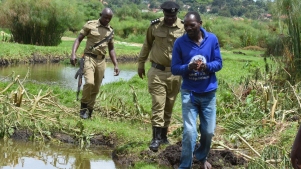
Environment police officers after arresting one of the suspected encroachers of Lubigi swamp in Busega, a Kampala suburb.
Forest management
The manifesto target was to increase forest cover to 11% to 15% by 2021.T forest cover has increased to 12.4% by 2019. Government was expected to increase involvement of the population in tree planting aimed at planting 100 million trees in the Manifesto’s five years. Over 103,927,130 million assorted tree seedlings were raised through NFA, the ministry and Private Seedling Nurseries and surpassed the target.
The Manifesto committed to invest in forest plantation development at a rate of 2,500 ha per year (i.e. 12,500Ha for five years) while maintaining the existing and subsequent young forest crops. This has been achieved and surpassed the target with over 43,866Ha of quality commercial plantations covering new plantations established by private investors in CFRs, NFA and District Forest Services in Local Forest Reserves.
The manifesto committed that the total external boundary of 12,000km of the 506 CFRs under the management of NFA requires opening, re-surveying and regular maintenance. This has been done by NFA alongside other activities to effectively secure the integrity of the Central Forest Reserves. Only 2,752 km (23%) have so far been covered.
Wetlands management
Our target was to increase wetlands coverage from 10 per cent to 12 per cent by 2021. However the converge has stagnated to less than 8.9 per cent.
At the same time, the Manifesto committed to up scale the restoration degraded section of wetland. At least 19,480Ha critical wetland ecosystems that were under great threat of encroachment and degradation were identified and earmarked for restoration and demarcation, to ensure that their integrity is maintained.
To date government has restored 10,263.6Ha of degraded critical wetlands which include Katonga-Sembabule, Mikomago-Masaka, Lubigi-Wakiso and Limoto-Pallisa, Lwere wetland in Bukedea, Nyamirembe in Bushenyi, Kibimba wetland in Gomba, Chosan-Cholol wetland in Nakapiripirit. Others are Kumi, Kampala, Kasese, Aleptong, Pallisa, Ngora, Bukedea, Manafwa, Buhweju, Masaka, Jinja, Kamwenge, Masindi, Hoima, Arua, Kaliro, Gulu, Dokolo, Luwero, Iganga, Mbale, Kibuku, Sheema, Isingiro, Buhweju, Buyende, Namutumba, Pallisa, Kabale, Kisoro, Amuria, Kamuli, Buyende, Maracha, Mbarara, Ntugamo, Kiruhura, Kanungu, Wakiso, Kayunga and Lwengo.
The NRM government promised to demarcate 2,880Kms of boundaries of major critical wetlands in 18 districts. To date, a total of 1,728.5 kms of critical wetlands boundaries have been demarcated with pillars and beacons in districts of Gulu, Lira, Mbale, Bushenyi, Hoima, Jinja, Masindi, Amuria, Kaliro, Buyende, Namutumba, Iganga, Rakai, Sheema, Buhweju, Alebtong, Dokolo, Kisoro, Kabarole, Wakiso and Arua.
State Minister for Environment Beatrice Atim Anywar
Environmental Management
The Manifesto commitment is to scale up the Municipal Solid Waste compositing facilities. Under Phase I, nine municipalities of Lira, Soroti, Mbale, Jinja, Mukono, Fort Portal, Kasese, Mbarara, and Kabale were supported to develop modern solid waste management facilities for composting and turning waste into organic manure to promote agricultural production and productivity as well as generating income.
Phase II was extended to other eight municipalities that include Arua, Gulu, Tororo, Busia, Entebbe, Mityana, Hoima and Masindi. These were supplied with solid waste management equipment like skip loaders, and wheel loaders, while the towns of Arua, Masindi and Hoima have been provided with composting plants. A new biogas project was setup in 2018 to support the composting plants to convert Municipal Solid waste into Biogas targeting the three municipalities of Jinja, Mbale, Masaka and Kampala City.
The Manifesto earmarked its commitment to continue with the operationalization of the Environmental Protection Police (EPP) to enhance compliance monitoring and law enforcement in Forests and Wetlands. The current Environment Protection Police Unit (EPPU) manpower stands at only 186 personnel, compared to the force of 350 required in the short to medium term.
Weather information
In an effort to provide accurate and timely weather information for better planning and delivery on all the Manifesto commitments the sector acquired three RADARS and this increased the functionality of weather and climate monitoring stations from 25% to 44%, which has greatly improved the accuracy and reliability of weather forecasts.
Additional progress has been recorded in dissemination of monthly weather updates to the public through local media, District Production Officers and registered farmer groups for decision making at the districts.
Challenges
Overall, the Water and Environment sector performance in terms of the implementation of NRM Manifesto commitments and the Presidential Strategic Guidelines is rated at 70 per cent. The sector has been constrained by a number of implementation challenges, including:
a. The safe water coverage has not increased as expected due to fast the growing population amidst the limited resources to invest in high cost technologies that can make a difference in population served with safe water source per village.
b. Secondly the District Water and Sanitation Conditional Grant has remained stagnant at Shs52b for the last 15 years despite the increase in number of local governments. To date on average a district receives Shs370m for construction of water points and office running.
c. There are land disputes in some of the areas where the water and Environment infrastructures was to be implemented such as at Acanpii dam in Oyam district. To some extent the communities resist construction of water supply schemes and facilities while others demand exorbitant sums of money for land compensation.
d. The unanticipated delays in the completion of feasibility studies and designs under the ministry and NWSC equally affected planned commencement of projects.
e. Continued degradation of water catchments and the general environment, lack of maintenance of water bodies and rivers, inadequate protection of lake shores, river banks and wetlands, and inadequate enforcement of water and environmental laws and regulations continue to be the main causes of flooding and destruction of property in the country.
f. Demarcation and restoration of wetlands and forests is ongoing but efforts are over stripped by the level of degradation.
g. There is inadequate funding especially at the Local Governments where Shs0.790b is provided to 134 districts annually instead of the desired Shs.15b need annually to restore and protect forest and wetlands countrywide.
h. The inadequate number of Environmental Police Protection Unit (EPPU) has also affected effective enforcement for environment protection countrywide.
Conclusion
The sector will continue to address the challenge of environmental degradation by strengthening enforcement of applicable laws, protecting and managing the quantity and quality of water resources, forest and critical wetland in order to reverse the current negative impacts to the infrastructure and peoples livelihoods.
This story is sponsored by the Government of Uganda.



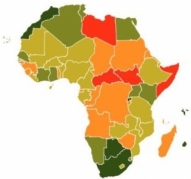




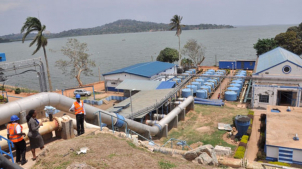
 Residents of Nabukalu Sub-county on January 28 fetching water from the Shs2b solar-piped water plant, which was constructed by National Water and Sewerage Corporation.
Residents of Nabukalu Sub-county on January 28 fetching water from the Shs2b solar-piped water plant, which was constructed by National Water and Sewerage Corporation. Moyo local leaders and officials from Water and Environment ministry carry a pipe during a ground-breaking ceremony of Moyo Town Council Water Supply and Sanitation project on 14 January,2021.
Moyo local leaders and officials from Water and Environment ministry carry a pipe during a ground-breaking ceremony of Moyo Town Council Water Supply and Sanitation project on 14 January,2021.
